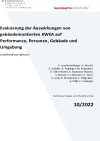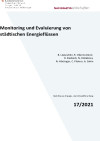Suchergebnisse
SmallWindPower@Home - Evaluierung der Auswirkungen von gebäudemontierten Kleinwindenergieanlagen auf Performance, Personen, Gebäude und Umgebung

Im Projekt „SmallWindPower@Home“ erfolgte eine messtechnische Evaluierung der Auswirkungen von komplexen Hindernissen auf die Anströmung und Performance unterschiedlicher gebäudemontierter Kleinwindenergieanlagen (KWEA). Darüber hinaus wurden deren Auswirkungen auf das Gebäude, dessen Bewohner und die unmittelbare Umgebung untersucht.
Schriftenreihe
10/2022
K.Leonhartsberger, A. Hirschl,S.Schidler, B. Priglinger, M. Peppoloni,D.Österreicher, K. Baumann-Stanzer,S.Stenzel, C. Lotteraner, T. Duer,K.Leeb, K. Strohkendl, C. Tiefgraber,A.Stökl, F. Lachinger
Herausgeber: BMK
Deutsch, 166 Seiten
Downloads zur Publikation
BIMaterial Process Design for Material Building Pass
Building Information Modelling supported compilation of a Material Building Pass; as a qualitative and quantitative documentation of the material composition of, and the material distribution within, a building structure. This project is a central milestone towards standardized, BIM-generated building material passes.
smart façade - energy potential of adaptive façade systems
A specially developed simulation model is employed to ascertain the energetic potential of adaptive façade systems. The dynamic behavior of the physical properties of the adaptive façade system reacts to both internal and external changing conditions. The goal was the development of an adaptive façade, which helps provide maximum comfort for the building occupants with minimum energy consumption.
HEROES - Häuser für Energie und RessOurcenEffiziente Siedlungen
Ein vereinfachtes Verfahren für die Berechnung von ökologischen Kennzahlen für bisher nicht betrachtete Gebäudeteile (thermisch nicht relevante Bauteile und Haustechnikkomponenten) wird entwickelt. Die methodischen Grundlagen für die Berechnung der Primärenergie u. der CO2-Emissionen im Betrieb und in den verbauten Materialien werden harmonisiert.
Monitoring und Evaluierung von städtischen Energieflüssen

Ausgangsbasis für das Projekt sind die Energiestatistiken. In einem ersten Schritt wird die Erhebungsmethodik im Detail analysiert. Basierend auf den Erkenntnissen der Analyse wird eine Methodik zur Erstellung städtischer Energieflüsse erstellt. Diese wird mithilfe des zu entwickelnden Planungsinstruments "Senflusk" an 5 Referenzstädten getestet.
Schriftenreihe
17/2021
B. Lepuschitz, R. Obernosterer, H. Daxbeck, N. Kisliakova, N. Hörzinger, C. Ploiner, A. Sahin Berichte aus Energie- und Umweltforschung 17/
Herausgeber: BMK
Deutsch, 65 Seiten
Downloads zur Publikation
scaleFLEX - Scalable method for optimizing the energy flexibility of districts
Development of a decentrally organized automation method for improving the demand-side flexibility options of buildings and districts. The utilized data-driven algorithm promise high scalability and therefore low installation and operating costs. The developed method will be validated using different building types (high-tech office buildings, low-tech office buildings, residential buildings).
PEAR - Prüfstand für energieeffiziente Automation und Regelung von Gebäuden
Der mit dem Planungsstand errechnete Energiebedarf deckt sich oft nicht mit den gemessenen Werten des Betriebs. In diesem Projekt werden Automation und Regelung auf den Prüfstand gestellt und eine Lösung zur Bewertung der Energieeffizienz von Regelstrategien in den Bereichen Raumlufttechnik, Betonkernaktivierung und Free Cooling entwickelt, welche anhand des Bauprojekts „Post am Rochus“ validiert wird.
Indicators for urban areas – for construction, operation and mobility in climate-friendly areas
Development and coordination of indicators for energy and ecological evaluations of urban areas based on the Swiss 2000-Watt certification system. The results will be used for the development of a quality assurance system for urban areas similar to the klimaaktiv declaration for buildings and the e5 certification for communities.
solSPONGEhigh - Hohe solare Deckungsgrade durch thermisch aktivierte Bauteile im urbanen Umfeld
Im Forschungsprojekt solSPONGEhigh wurde die intensive Nutzung von thermisch aktivierten Bauteilen (TABs) als zusätzlicher thermischer Speicher in verschiedenen Gebäuden unter vorrangigem Einsatz von Solartechnologien (Solarthermie bzw. Photovoltaik) untersucht. Die Arbeitshypothese ging davon aus, dass durch die Aktivierung und Nutzung der bauteilimmanenten thermischen Speicher eine Deckung des Gebäudeenergiebedarfs mit Solartechnologien von bis zu 100 % erreicht werden könnte.
smart façade - energetische Potentiale von adaptiven Fassadensystemen
Ermittlung der energetischen Potentiale von adaptiven Fassadensystemen unter Einsatz eines eigens dafür entwickelten Simulationsmodells. Das dynamische Verhalten der physikalischen Eigenschaften von adaptiven Fassaden wird dabei von den NutzerInnen und den klimatischen Umgebungsbedingungen beeinflusst. Ziel war die Abbildung einer adaptiven Fassade mit maximalem Komfort für die NutzerInnen bei gleichzeitig minimalem Energieeinsatz.
HOTSPOTS - Holistic thermographic screening of urban physical objects at transient scales
Die Projektidee verknüpft messtechnische Innovationen in der Erfassung und Generierung stadtbezogener Daten mit neuartigen Prozessketten in der Datenauswertung und Analyse. Auf Basis wissenschaftlicher Ansätze erarbeitet HOTSPOTS eine durchgängige Verfahrenskette die künftige Auswahlverfahren im Bereich von baulichen Maßnahmen der Stadtentwicklung auf eine nachvollziehbare und (mess-)datengetriebene Basis stellt, und somit das Risiko von ad-hoc Entscheidungen oder Fehlinvestitionen reduziert.
HOTSPOTS - Holistic thermographic screening of urban physical objects at transient scales
HOTSPOTS enables new insights and perspectives for city development. According to the project idea innovations in acquisition and sensing as well as densification of geo-referenced city related data are supplemented by novel processing chains in city data analytics. Driven by an integrated scientific approach we develop a novel method in the selection, evaluation and prioritization of infrastructural city development measures which is directly derived from sensed data hence reducing the risk of ad-hoc decisions or lack in impact.
see-it - Camera based, user centric daylight control system for optimized working conditions
In the project technologies in the field of building construction and building automation are being researched for quality and performance improvements in the workplace. The aim is to individualize the control of sun protection to the people who need to be protected from glare and overheating and hope to see through.
StromBIZ - Demonstrationsprojekte: Geschäftsmodelle dezentrale Stromerzeugung und Distribution
Ein "Tipping Point" bei der Umsetzung der Energiewende sind Geschäftsmodelle zur Vor-Ort-Nutzung von regenerativ erzeugtem Strom. Es wurden anhand von mehreren Demonstrations-PV-Anlagen auf Wohn- und Nichtwohngebäuden neue Geschäftsmodelle der dezentralen Stromerzeugung und Distribution entwickelt, implementiert, getestet und schließlich kommuniziert.
solSPONGEhigh - High solar fraction by thermally activated components in an urban environment
Within this project the intensive use of thermally activated building elements (TABs) as an additional thermal storage in different buildings, with solar technologies (thermal, PV) preferred for energy supply, was investigated. The aim was to activate and use the thermal storage potential that is immanent in the building elements and thereby achieve solar coverage of the building's heat demand of nearly 100 %.
BIM4BIPV - Future aspects of building-integrated photovoltaics (BIPV) in cross-system BIM planning
Research into an end-to-end BIM planning flow for energy-optimised, building-integrated photovoltaics (BIPV) that simultaneously generates solar energy, enables optimal use of daylight and provides shading.
BIMaterial Prozess-Design für einen BIM-basierten, materiellen Gebäudepass
Generierung des materiellen Gebäudepass (MGP) - Dokumentation der materiellen Zusammensetzung eines Bauwerkes, die quantitative und qualitative Auskunft über die relevanten Rohstoffe in einem Bauwerk gibt. Als Information und Datenbasis für das MGP wurde die Building Information Modelling Methode und ein digitales Gebäudemodell verwendet. Als Ergebnis wurde ein Pflichtenheft für eine BIM-basierte MGP App geschaffen werden.
BIM2BEM Flow - Kontinuierliche, BIM-basierte Energieeffizienzplanung
Durch eine automatisierte Integrierung und Zuweisung der Austauschanforderungen zwischen Entwurfs- und Simulationsprogramm anhand der ausgearbeiteten Austauschinformationsanforderungen, soll eine kontinuierliche Energieeffizienzplanung entlang der Entwurfsphase ermöglicht werden.
BIM4BEMS - Building Information Modeling for Building Energy Management Systems
BIM4BEMS explores use cases that represent the usage of building information models (BIM) in combination with building energy management systems (BEMS) during operation. This enables the interaction between BIM and building management systems (BMS) which improves the analysis and visualization of inefficiencies in facilities.
BIM4BEMS - Building Information Modeling for Building Energy Management Systems
BIM4BEMS untersucht Anwendungsfälle, die den Nutzen eines BIM-Modells in Kombination mit Energiemanagementsystemen (BEMS) im Betrieb darstellen, die die Verbindung zwischen BIM und Gebäudeleittechnik (BMS) erlauben, und somit zu verbessertem Reporting und Erkennung von Ineffizienzen im bestehenden Gebäudebetrieb führen.
